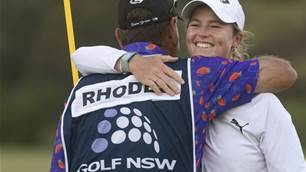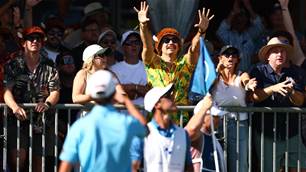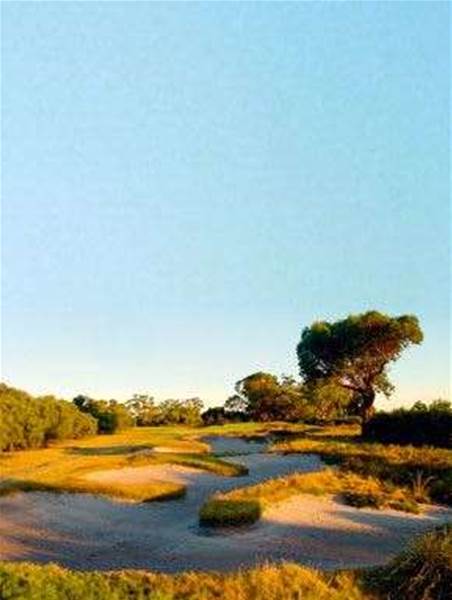In golfing terms, Melbourne truly ranks with the greatest of destinations – and it sometimes takes an outsider, or a bunch of them, to remind us of that.
In golfing terms, Melbourne truly ranks with the greatest of destinations – and it sometimes takes an outsider, or a bunch of them, to remind us of that.
 Kingston Heath’s par-3 15th.
Kingston Heath’s par-3 15th.Images: Tourism Victoria
As the golf correspondent for the Associated Press, Doug Ferguson is on the ground at more tournaments during the year than anyone else in the press corps - and many of the players, for that matter.Always identifiable inside the ropes for his Hawaiian shirts, he’s a fixture of the pro tour, someone who’s seen plenty of the golfing landscape, and every airport, hotel and rental-car depot in between.Two year ago, he tracked Tiger Woods on his long-awaited return to Melbourne for the Australian Masters at Kingston Heath. Eager to pick Ferguson’s brain, I asked him about the places he had travelled to for golf. He brought up a defunct tour event in a remote part of rural Georgia, where, the story goes, American star Davis Love showed up for his tee time with eye black still on his face, having spent the morning hunting. He mentioned how it always amazed him that the British could take the Open Championship to tiny seaside towns and run the event beautifully. With an upcoming US Open at Pebble Beach, he talked of how excited he was at getting to spend another working week on the glitzy Monterey Peninsula.
And what was the best? Ferguson had anticipated the question. “I know I’m not catering to your audience,” he replied, thinking that I expected him to name-drop some far-flung locality in California or the Carolinas, Scotland or Ireland, for Southern Hemisphere travellers to dream about. “But it’s here. Melbourne.”Ferguson might have been engaging in golf’s customary politesse to that week’s host, but there’s reason to believe he was being sincere. In golfing terms, Melbourne truly ranks with the greatest of destinations – and it sometimes takes an outsider, or a bunch of them, to remind us of that. The Presidents Cup, the biennial team competition that pits the United States against the rest-of-the-world outside of Europe, will turn the attention of the golf world to the Royal Melbourne Golf Club later this year, following on its first visit in 1998. The visitors will gush, as the course remains by far the best the Cup has ever played.It might be a case of familiarity breeding contempt, or a simple matter of taking things for granted. In Victorian tourism circles, the old trope goes that Melbourne has to invest in events because it has no Harbour Bridge or Barrier Reef, no great “assets” either man-made or natural. In the context of golf, nothing could be further from the truth – the courses of the Sandbelt, the stretch of land in the city’s suburban south-east, are esteemed in the rather esoteric field of golf architecture for how they balance their ingenious design with an authentic naturalism. These courses bear an unmistakable stamp – where many new layouts in Asia or the Middle East look like they were air-dropped in from the US, the Sandbelt’s tracks take on the character of their setting, another quality which sets them apart on the global scale.
They also have the benefit of being associated with perhaps the greatest golf course architect in history. Much as Gaudi pervades the shape of Barcelona, or Frank Lloyd Wright is inseparable from Chicago, golf in Melbourne is indelibly linked to Alister Mackenzie. The Scottish doctor, designer of Augusta National and Cypress Point among others, was brought out to Australia by Royal Melbourne in 1926 to work on their course. Few other seven-week periods in golf history could be rivalled for productivity, as Mackenzie not only consulted on Royal Melbourne but 18 other courses around the country, and almost all of the leading clubs of the Sandbelt (Royal earned a commission on the extra work it found for him, and ended up making a profit on his trip).
The sum of Mackenzie’s efforts was a lasting influence that would, pardon the pun, change the course of Australian golf. There is debate about how much credit is paid to him – for one, Mackenzie never saw his work finished – over his equally important local collaborators, the Australian Amateur champion Alex Russell and Royal Melbourne superintendent Mick Morcom. But with the way they carried forth Mackenzie’s design precepts, it can be properly said that course architecture in Australia can draw a dividing line at what was done before the doctor’s visit and after it.
Mackenzie’s plan for the routing of Royal Melbourne’s West course sits in a frame on the wall of the general manager’s office at the club. There are minor differences to the course in the ground today, but the flow of the holes, with the brief interlude on the back nine that crosses over the road, is unmistakable. If you think of a golf course as a movie, then the routing is the script, the thing that draws together the individual characters and plot points into a coherent whole. Royal’s script is seamless from the opening hole, whose unmissably wide fairway sounds the first note of what is to come.
Related Articles

Lightning and low rounds at NSW Women’s Open

"More pointless than Pokémon": Tomorrow's Golf League critiqued, and roughly













